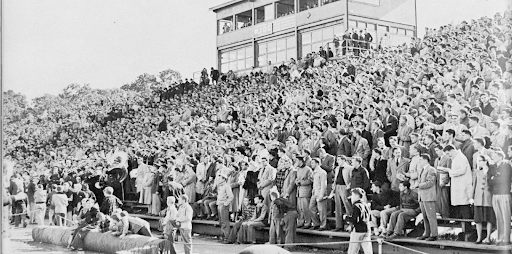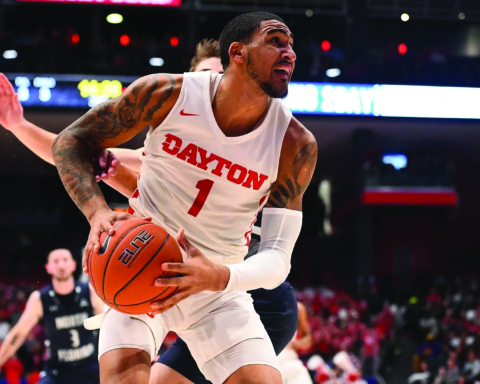Photo: SBU Archives
BY: CARSON HAYEK, STAFF WRITER
While students today pile into the Reilly Center for basketball games, students in the early 1900s piled into St. Bonaventure University’s four stands of bleachers to watch Bonaventure football games.
Created in 1895, the student body of Bonaventure raised money for the program to afford equipment and schedule games against local opponents. According to multiple school records, the program was shut down in 1897 due to football being a distraction from academic objectives. However, in 1903 Bonaventure football was approved to play again by school president Joseph Butler.
Bonaventure played its football games at numerous locations. In the early stages of the program, Bonaventure would play at Buffalo Civic Stadium and Bradner Stadium to draw larger crowds. From 1946-1951, the team played on campus at Forness Stadium. Today, The Administration Building sits adjacent to the land where 25,000 rowdy Bona’s students, alum and community members would gather to watch games
As the program evolved, school president Thomas Plassman determined an experienced coaching staff was needed. The university hired Notre Dame assistant, Glen Carberry as head coach in 1924. Bonaventure would also add Notre Dame’s, Carrol “Mike” Reilly as an assistant to the staff. Reilly would later take over head coaching duties from 1930-1942 and was also instrumental in Bonaventure’s basketball program. So much so, that the current basketball arena, the “Reilly Center,” is named after him.
With a greater program reputation came a greater level of competition.
In 1922, Bonaventure would travel down to Central Pennsylvania. The Bonnies played the now modern-day powerhouse, Penn State Nittany Lions. The final score was 99-0 in favor of Penn State.
Bonaventure would play other notable Division I colleges over the years such as Boston College, Army, Rutgers, Ohio, Buffalo, Cornell and Princeton. The Bonnies also faced nearby smaller schools such as Canisius, Niagara, Alfred, Ithaca, and Allegheny.
World War II forced a temporary shutdown for Bonaventure football according to attendance records. The team returned in 1946 under future Philadelphia Eagles and Green Bay Packers head coach, Hugh Devore. Devore led the team to success on the field, even making it to the first-ever Tobacco Bowl in 1948. Despite being labeled as a “bowl” game, it was not a postseason matchup and typically featured two rival teams. Even with the on-field success, the university could no longer afford to have the team.
According to a Bona Venture newspaper report from the years 1948-1952, the university was losing nearly $50,000 ($700,000 today) a year from the football program. With other local schools such as Niagara and Canisius ending their football program, a proposal from the board of trustees was passed in 1951 to end the Bonnies football team.
Despite college football receiving a 12% viewership boost year to year according to ESPN, Bob Beretta, Bonaventure’s athletic director has no plans to reinstate the sport.
“I don’t think students should expect football [anytime soon],” said Beretta. “Football is a beast of its own. As someone who spent the majority of their career with major responsibilities of a football program, it takes a tremendous number of resources and commitment. It takes over the culture of a campus and can be disruptive if it’s in the wrong environment.”
The resources it would take for Bonaventure football to return would be too costly, said Beretta.
“From a resource standpoint, it would take $8-10 million to start up a program at the Division I level,” said Beretta. “That’s without even considering NIL ramifications and I am not even sure we can get there economically.”
The cost of the return isn’t the only issue. It would also create many logistical issues at the university, according to Beretta
“If we added [85] football scholarships on the men’s side, you have to keep Title IX in mind,” said Beretta. “You would have to add [85] scholarships on the woman’s side too. That then affects enrollment and housing settlements. If we added [170] new students, where would they live? It just becomes a logistical issue for the institution.”
Football requires both a football field and stands-neither of which Bona’s campus has.
“We currently have no facility close by,” said Beretta. “It could take $100 million to build a stadium to begin with. It’s clearly the biggest obstacle we have. It’s just the lack of a ready facility, football is the ultimate 800-pound gorilla.”
With football unlikely to make a return, Bonaventure will continue to stay undefeated since 1951.
hayekc24@bonaventure.edu




